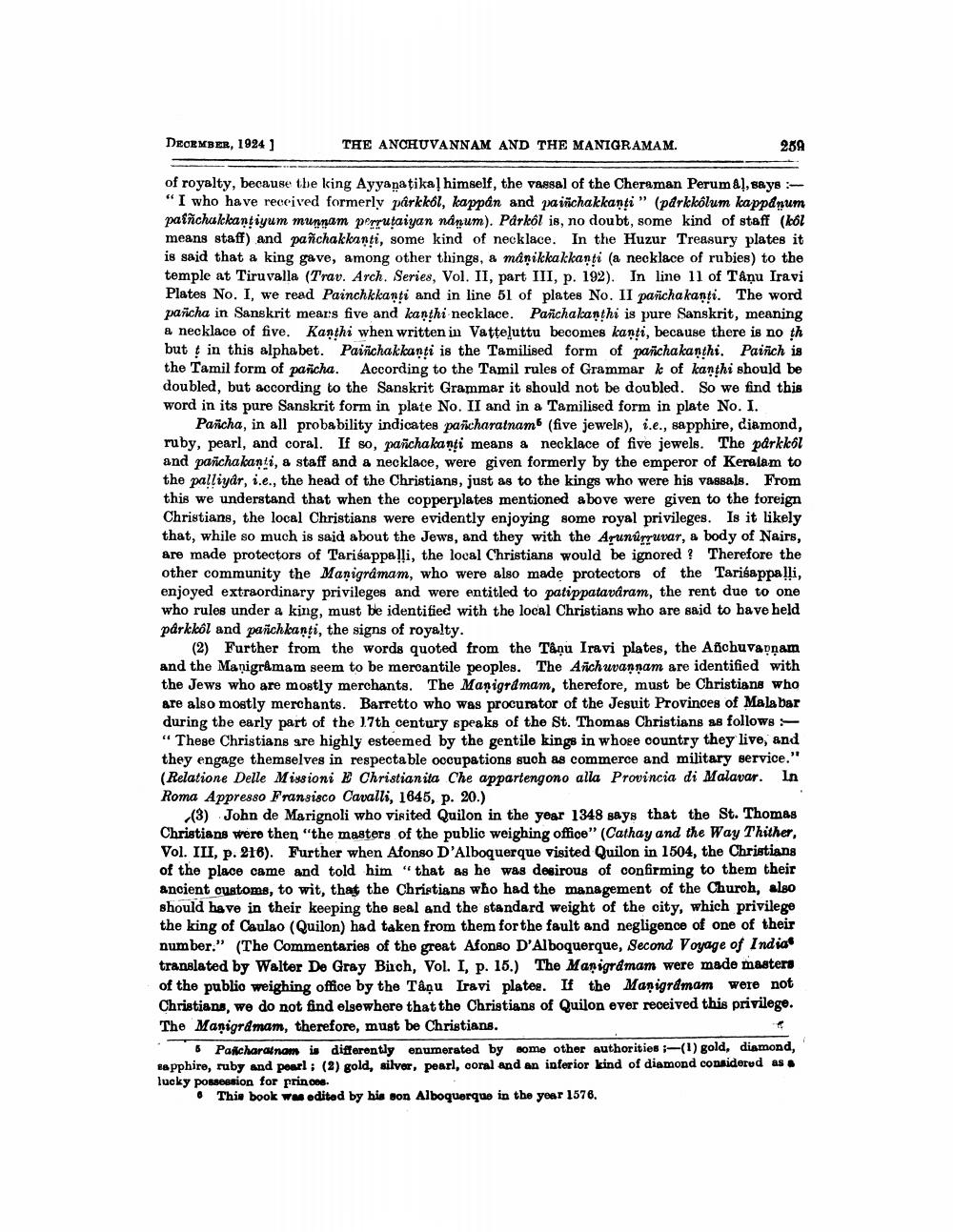________________
DECEMBER, 1924 1
THE ANCHUVANNAM AND THE MANIGRAMAM.
289
of royalty, because the king Ayyanaţika! himself, the vagsal of the Cheraman Perumal, says - “I who have received formerly párkkol, kappan and paiñchakkani" (pdrkkôlum kappanum pafñchakkantiyum munnam perrutaiyan nánum). Párkól is, no doubt, some kind of staff (kól means staff) and pañchakkanti, some kind of necklace. In the Huzur Treasury plates it is said that a king gave, among other things, a manikkakkanti (a necklace of rubies) to the temple at Tiruvalla (Trav. Arch. Series, Vol. II, part III, p. 192). In line 1l of Taņu Iravi Plates No. I, we read Painchkkanti and in line 51 of plates No. II pañchakanti. The word pafcha in Sanskrit mears five and kanthi necklace. Panchakanthi is pure Sanskrit, meaning a necklace of five. Kanthi when written in Vatteluttu becomes kanti, because there is no th but in this alphabet. Paiñchakkanti is the Tamilised form of pañchakanthi. Paiñich is the Tamil form of pañcha. According to the Tamil rules of Grammar k of kanthi should be doubled, but according to the Sanskrit Grammar it should not be doubled. So we find this word in its pure Sanskrit form in plate No. II and in a Tamilised form in plate No. I.
Pañcha, in all probability indicates pañcharatnam (five jewels), i.e., sapphire, diamond, ruby, pearl, and coral. If so, panchakanti means & necklace of five jewels. The parkkól and panchakanti, a staff and a necklace, were given formerly by the emperor of Keralam to the palliyar, i.e., the head of the Christians, just as to the kings who were his vassals. From this we understand that when the copperplates mentioned above were given to the foreign Christians, the local Christians were evidently enjoying some royal privileges. Is it likely that, while so much is said about the Jews, and they with the Arunúrruvar, a body of Nairs, are made protectors of Tari appalli, the local Christians would be ignored? Therefore the other community the Manigramam, who were also made protectors of the Tari appalli, enjoyed extraordinary privileges and were entitled to patippatavaram, the rent due to one who rules under a king, must be identified with the local Christians who are said to have held pårkkôl and pañchkanti, the signs of royalty.
(2) Further from the words quoted from the Tâņu Iravi plates, the Añchuvarnam and the Manigramam seem to be mercantile peoples. The Anchuvannam are identified with the Jews who are mostly merchants. The Manigramam, therefore, must be Christians who are also mostly merchants. Barretto who was procurator of the Jesuit Provinces of Malabar during the early part of the 17th century speaks of the St. Thomas Christians as follows: “These Christians are highly esteemed by the gentile kings in whose country they live, and they engage themselves in respectable occupations such as commerce and military service." (Relatione Delle Missioni E Christianita Che appartengono alla Provincia di Malavar. In Roma Appresso Fransisco Cavalli, 1645, p. 20.)
(3) John de Marignoli who visited Quilon in the year 1348 says that the St. Thomas Christians were then "the masters of the public weighing office" (Cathay and the Way Thither, Vol. III, p. 216). Further when Afonso D'Alboquerque visited Quilon in 1504, the Christians of the place came and told him that as he was desirous of confirming to them their ancient customs, to wit, that the Christians who had the management of the Churoh, also should have in their keeping the seal and the standard weight of the city, which privilege the king of Caulao (Quilon) had taken from them for the fault and negligence of one of their number." (The Commentaries of the great Afonso D'Alboquerque, Second Voyage of India translated by Walter De Gray Birch, Vol. I, p. 15.) The Manigramam were made masters of the publio weighing office by the Tâņu Travi platee. If the Manigramam were not Christians, we do not find elsewhere that the Christians of Quilon ever received this privilege. The Manigramam, therefore, must be Christians.
6 Pafcharatnam is differently enumerated by some other authorities :-(1) gold, diamond, Es pphire, ruby and pearl ; (2) gold, silver, pearl, coral and an inferior kind of diamond considerud as lucky possession for princos.
This book ww edited by his son Alboquerque in the year 1576.




